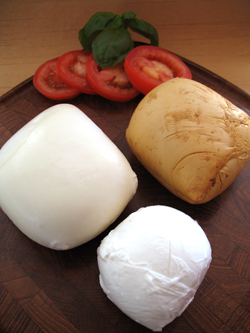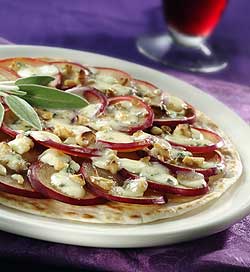

Beyond pepperoni: This White Cheddar Pizza includes bacon and walnuts. Get the recipe. Photo courtesy Wisconsin Milk Marketing Board.
October 2008
Last Updated April 2017
|
 |
Gourmet Pizza Recipes
Page 1a: History Of Pizza, Continued
CAPSULE REPORT October is National Pizza Month. This most popular of American dishes started out as a primitive flatbread and cheese meal somewhere in the Mediterranean region. While pepperoni wins as America’s favorite topping, the folks at Wisconsin Milk Marketing Board—whose members make much of the great cheese that tops your pizzas—have developed some groovy recipes that let you defer the tried-and-true pepperoni, meatballs, mushrooms, onions and pepper for another day. So call your friends, tell them to bring the craft beer or artisan soda, and celebrate National Pizza Month in gourmet style. But before you hit the recipes, chow down on the history of pizza.
This is Page 1 of a seven-page article. Click the black links below to visit other pages.
The History Of Pizza (Continued)
The Introduction Of Mozzarella Cheese
Now we’ve got the tomato. What about the mozzarella?
In Italy, the best mozzarella is made from the milk of the Asian water buffalo (Bubalus bubalis). Mozzarella di bufala is five times more expensive than cow’s milk mozzarella, but worth it.
The Asian bufflo was introduced to the southern region of Campania in the sixth century C.E.
Although most of today’s pizza is made with the more affordable cow’s milk mozzarella, it is believed that mozzarella di bufala was the magic binder that created today’s pizza as we know it.
Some people argue that Hannibal brought the water buffalo back from Carthage, the Phoenician city located in modern Tunisia, during the Punic Wars in the third century B.C.E.
Under this theory, they would have crossed the Alps along with the elephants. Although the number of elephants and horses that left on the journey has been documented, there was no mention of water buffalo.
What is known is that for centuries, semi-wild water buffalo have grazed in the Pontine marshes and on the lush pastures of Campania, and that they came from somewhere, as they are not native to Italy. The herds are now carefully fed so that they produce high-quality milk.
|
|

Three forms of mozzarella from Mozzarella Fresca, a NIBBLE Top Pick Of The Week. From top right: smoked, fresh water-packed and vacuum-packed. Photo by Melody Lan | THE NIBBLE. |
References to “mozza” begin to appear in the 1200s, and “mozzarella” appears from 1500 on. At all times it was associated with water buffalo milk. Because of its perishability, it was produced and consumed locally.
In the beginning mozzarella, because of its perishability, was mainly destined to the local consumption.
Pizzerias: From Street Food To Pizza Restaurants
Antica Pizzeria Port’Alba in Naples, Italy is regarded as the world’s first pizzeria. It began as a pizza bakery in 1738, providing street vendors with pizzas, but in 1830 expanded to include a pizza restaurant with chairs and tables. It remains in business today.
References to “mozza” begin to appear in the 1200s, and “mozzarella” appears from 1500 on. At all times it was associated with water buffalo milk. Because of its perishability, it was produced and consumed locally.
In the beginning mozzarella, because of its perishability, was mainly destined to the local consumption.
Real Neapolitan Pizza
What is “authentic pizza?” Established in 1984, the Associazione Verace Pizza Napoletana (AVPN, the The True Neapolitan Pizza Association) aims to protect authentic Neapolitan pizza.
|
|

Pear, Walnut and Gorgonzola pizza. See the recipe. Photo courtesy Wisconsin Milk Marketing Board. |
Yes, there are guidelines set by the Verace Pizza Napoletana Association, the Italian Government and The European Union.
- The pizzerias must use specific coal fired pizza ovens from Italy, San Marzano tomatoes and fior di latte mozzarella cheese.
- The dough must be made fresh daily from “00” flour.
-
The AVPN recommends but does not mandate, using Ferrarelle’s Natia brand of still mineral water, imported from the volcanic region of Naples. The mineral content in Natia matches the mineral content of public water in Naples, naturally high in calcium. The minerals impact the texture of the pizza and the way the dough performs in coal fired ovens. They also give the unique flavor to the crust. American tap water can vary greatly in mineral content and added compounds such as fluoride and chlorine, both will have a pronounced effect of dough characteristics.
Pizza In America
Pizza arrived in the U.S. with the first wave of Italian immigrants in the late 19th century. It remained a surface for traditional Italian toppings—pepperoni, sausage, meatballs, vegetables, seafood—with occasional creative expressions in communities catering to college crowds (such as “Hawaiian” pizza with ham and pineapple).
In the early 1980s, Wolfgang Puck, the German-born chef of Spago restaurant in West Los Angeles, gained national attention for his gourmet pizzas, with ingredients such as duck sausage and goat cheese and pesto. That unleashed the “designer pizzas” movement that continues today, featuring everything from Gorgonzola pizza with pears and walnuts to Brie pizza with lardons and arugula. That’s not such a long way from a mozzarella and sausage pie with fresh basil!
Chicago also contributed deep dish pizza, a.k.a. Chicago pizza, back in 1943. The record is sparse, and the invention is often credited to Pizzeria Uno’s founder, by Uno's founder Ike Sewell, although there is no documentation of that. It more likely may have been invented by Adolpho “Rudy" Malnati Sr., an employee who became a partner. Here are the facts gathered by the Chicago Tribune.
Pizza: An American Favorite
Depending on which survey you read, pizza or burgers is usually America’s favorite food. Our modern version of pizza is widely credited to a Don Raffaele of Naples. Queen Margherita (1851-1926) of Spain requested that he make her a special pizza, so he created one with basil, mozzarella cheese and tomatoes, which compose the colors of the Italian flag (green, white and red). The pie was thus named the “Margherita Pizza.”
The first American pizzeria opened as early as 1905, but it wasn’t until American GI’s returned from Italy in World War II that the dish really took off. Soldiers stationed there had become so attached to the pie while abroad that they demanded more of it once they returned home.
In the 1960s, the pizza industry expanded from local pizzerias, to large chains, home delivery and a vast selection of frozen pizzas in retail stores (check out one of our favorites, from Pizza Romana). Today, pepperoni ranks as the favorite topping, followed by mushrooms, extra cheese, sausage, green peppers and onions. The options are endless when it comes to homemade pizza, though. In addition to the twelve recipes that follow, let your imagination be your guide. After all, how far wrong can you go with pizza?
Continue To Page 2: Chicken Pizza Recipes
Return To The Article Index Above
Sources:
- Diwinetaste.com/dwt/en2003127.php
Recipes and photos courtesy of Wisconsin Milk Marketing Board. Other material
Lifestyle Direct, Inc. All rights reserved. Images are the copyright of their individual owners.

|






